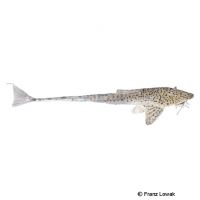Whiptail Catfish 'Peru II' (Pseudohemiodon sp. 'Peru II')
| Whiptail Catfish 'Peru II' Pseudohemiodon sp. 'Peru II' | |
|---|---|
| Name | Whiptail Catfish 'Peru II' |
| Name Lat. | Pseudohemiodon sp. 'Peru II' |
| Family | Suckermouth Armoured Catfishes |
| Family lat. | Loricariidae |
| Order | Catfishes |
| Order lat. | Siluriformes |
| Origin | Peru |
| Habitat | Rivers |
| Diet | Carnivore |
| pH | 6.0-7.0 |
| Behavior | Peaceful |
| Keeping | Pair, group |
| Care Level | Moderate |
| Reproduction | Mouthbrooder |
| Breeding | None reported |
| Life Span | 8-10 years |
| Protection | No |
| Metric Units | |
| Size | 15 cm |
| Temperature | 24-28 °C |
| Hardness | 1-10 °dH |
| Aquarium | ~ 200 l |
| US Units | |
| Size | 6" |
| Temperature | 75-82 °F |
| Hardness | 18-178 ppm |
| Aquarium | ~ 50 gal |
Distribution and habitat
The distribution area of the crepuscular Reticulated Flounder Catfish Peru II is in Peru. They live in shallow water preferably on sandy bottoms between fallen leaves, sunken branches and roots protruding into the water.
Maintenance
The aquarium should have a dense border planting with roots, round stones and caves (hiding places) as well as free sandy areas of fine-grained sand covered with some foliage (oak, sea almond tree). Subdued light and a medium current are ideal.
No ammonia, ammonium and nitrite should be detectable, the nitrate value should not exceed 100 mg/l. To ensure the water quality and oxygen content, a filter and heater adapted to the aquarium size is required, as well as lighting for the species-appropriate day-night rhythm of the animals.
Diet
They feed on animal food. The food supply consists of live, frozen and dry food. For a balanced diet, feed once a day with a high-quality, protein-rich dry food for loricariids (granules, pellets, chips, tablets) as well as zooplankton, mosquito larvae, shrimp, krill, snails, fish, crab and mussel meat (live or frozen).
Only feed as much as will be eaten within a few minutes. Regular and varied feeding promotes health and increases resistance.
Behaviour and compatibility
They are calm, peaceful catfish that should be kept in pairs or in a group of 3-5. Only during the spawning season they behave somewhat territorial. They can be kept very well in a community tank with other calm fish
Basically, only compatible fish species with similar demands on water conditions and water temperature should be socialized.
Sex dimorphism
The sexes are difficult to distinguish. Sexually mature males have a distinctly enlarged mouth and spawning females appear slightly rounder
Reproduction and breeding
There are no known reports of successful breeding in the aquarium.
Presumably, like other flounder catfish, they are paternal mouthbrooders. The male picks up the egg ball in a "lip pocket" for mouth brooding. The egg ball is aerated by moving the mouthparts. After 12-14 days, the larvae hatch and brood care is complete
Important
For protection and camouflage, they sometimes bury themselves in the sand.
Special attention should be paid to good water quality and a weekly partial water change is recommended
When catching, fine-meshed nets should be used as far as possible so that the hard rays of the pectoral fins or the skin teeth (odontodes) do not get caught on the bone plates, which can cause painful puncture wounds when touched.
The well-being of the fish should be checked regularly. Temperature should be checked daily, pH, hardness and nitrate levels at least every 14 days. Regular partial water changes are recommended, even when contaminant levels have not yet reached the upper limit. Sudden changes in water quality should be avoided. Newly introduced fish must be accustomed slowly to the water in the aquarium
Further literature can be found in your pet store.
References
Text: Werner Winter; Image: Franz Lowak
Source: BMELV (1998): Tierschutzgutachten - Haltung von Zierfischen (Süßwasser); SEIDL & EVERS (2005): Wels Atlas, Mergus Verlag; ENGELMANN (2005): Zootierhaltung - Tiere in menschlicher Obhut: Fische, Verlag Harri Deutsch
- Gemäß § 21 Abs. 5 Tierschutzgesetz idgF
